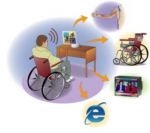Apr 28, 2005
Brain-machine Interface Test Promising
From Betterhumans
An experimental brain-machine interface has allowed a quadriplegic person to control a computer in what could be an early step to new assistive technologies for the disabled.

Cyberkinetics of Foxborough, Massachusetts has reported preliminary results for a pilot study of its BrainGate Neural Interface System, which the company aims to develop into a safe, effective and unobtrusive universal operating system for allowing disabled people to control devices using their thoughts.
"While these results are preliminary, I am extremely encouraged by what has been achieved to date," says study investigator Jon Mukand of Sargent Rehabilitation Center. "We now have early evidence that a person unable to move their arms, hands and legs can quickly gain control of a system which uses thoughts to control a computer and perform meaningful tasks. With additional development this may represent a significant breakthrough for people with severe disabilities."
Mental link
BrainGate, in a pilot study under a US Food and Drug Administration Investigational Device Exemption, uses an implanted neural signal sensor and external processors to allow users to control machinery.
The implanted sensor is about the size of a baby aspirin and contains 100 electrode probes thinner than a human hair. Implanted in part of the brain responsible for movement, the primary motor cortex, the probes detect the electrical activity of brain cells and relay this through a small wire exiting the scalp to a pedestal on the skull. A cable runs from the pedestal to a cart with computers, signal processors and monitors, allowing operators to study how well users can control their neural output.
For the reported study, an unidentified quadriplegic person with a three-year-old spinal cord injury had the sensor implanted this June in an approximately three-hour operation at Rhode Island Hospital in Providence. The procedure reportedly went as planned and the recipient has reportedly experienced no side-effects or problems healing.
Interactive mind
The study examined the recipient's use of BrainGate over two months and 20 study sessions. It found that the recipient could immediately adjust neural output in response to commands. It also found that a computer interface developed using the patient's thoughts allowed the subject to perform tasks and operate basic computer functions, including controlling a cursor, playing Pong with 70% accuracy and performing multiple tasks simultaneously, such as controlling a TV while talking.
While the findings are preliminary and based on a single patient, Cyberkinetics aims to enroll a total of five quadriplegic people between the ages of 18 and 60 who meet such criteria as being able to verbally communicate.
Each participant is expected to participate in a study for 13 months. Afterwards, participants can undergo surgery to have the device removed or choose to participate in future studies, which the first patient has chosen to do.
"Our ultimate goal is to develop the BrainGate System so that it can be linked to many useful devices, including for example, medical devices such as muscle stimulators, to give the physically disabled a significant improvement in their ability to interact with the world around them," says John Donoghue, chief scientific officer of Cyberkinetics.
The research was reported in Phoenix, Arizona at the 2004 annual meeting of the American Academy of Physical Medicine and Rehabilitation.
Cyberkinetics plans to announce more results and observations from the pilot study in San Diego, California at the 2004 annual meeting of the Society for Neuroscience.
14:45 Posted in Brain-computer interface | Permalink | Comments (0) | Tags: Positive Technology, brain-computer interface







The comments are closed.